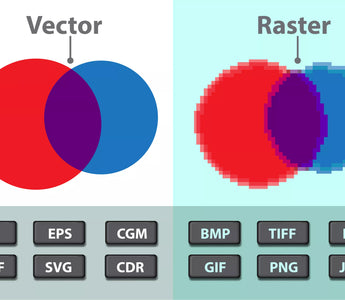Designing and getting your design onto a garment is a little more complex than first meets the eye, however, with the right artwork file we can achieve amazing things together!
What we really need is a Vector File.
What is a Vector File?
A vector file is a type of computer graphic that is based on mathematical expressions rather than pixels. Unlike raster images, which are composed of a grid of individual pixels, vector files use mathematical equations to define shapes, lines, and colors. This allows vector graphics to be scaled to any size without losing quality, making them ideal for logos, illustrations, and other graphics where scalability is important.
Common vector file formats include:
-
SVG (Scalable Vector Graphics): A widely used XML-based vector image format that is supported by most web browsers.
-
AI (Adobe Illustrator): Adobe Illustrator's native file format, which can contain vector graphics, including paths, shapes, and text.
-
EPS (Encapsulated PostScript): A versatile vector file format often used for print graphics and page layouts.
-
PDF (Portable Document Format): While PDFs can also contain raster images, they can include vector elements, making them suitable for both print and digital distribution.
Important to note, that just renaming your file with any of these file types does not make it a vector. To convert a raster (or flat image file) into a vector it must be redrawn. We offer this service, but it is time consuming so there is a charge. Once we have done this for you, we will send you the vector formats so you have this file type for any future needs.
Sublimation & Vector Files
Sublimation is a printing process commonly used for creating vibrant and long-lasting images on various substrates, such as apparel, ceramics, and promotional items. When it comes to sublimation printing, vector files are preferred for several reasons:
-
Scalability without loss of quality: Vector files are resolution-independent, meaning they can be scaled to any size without losing quality. This is crucial in sublimation, where the printing process involves transferring ink onto a substrate by turning it into a gas and then solidifying it. Vector graphics ensure that the image remains crisp and clear regardless of the size of the final print.
-
Smooth and precise lines: Vector files define shapes using mathematical equations, resulting in smooth, clean lines. This precision is essential for sublimation, especially when intricate designs, logos, or text need to be accurately reproduced.
-
Color consistency: Vector files often contain information about the colors used in the design, usually in the form of Pantone or CMYK values. This ensures consistent color reproduction during the sublimation process, helping to maintain the integrity of the intended design.
-
Editable components: Vector files are easily editable, allowing designers to make adjustments to the design elements, colors, and shapes as needed. This flexibility is valuable in the sublimation process, where customization is often required for different substrates and client preferences.
-
Layer support: Vector file formats, such as AI (Adobe Illustrator), often support layers. Layers allow for the organization of different elements within the design, making it easier to manage and modify specific parts of the image without affecting others.
In summary, using vector files in sublimation printing ensures that the final output is of high quality, scalable, and easily customizable, this means we can deliver a high quality garment to you from the fabric to the design and print.
Do you need help with vector files? Get in touch and we can help out.








